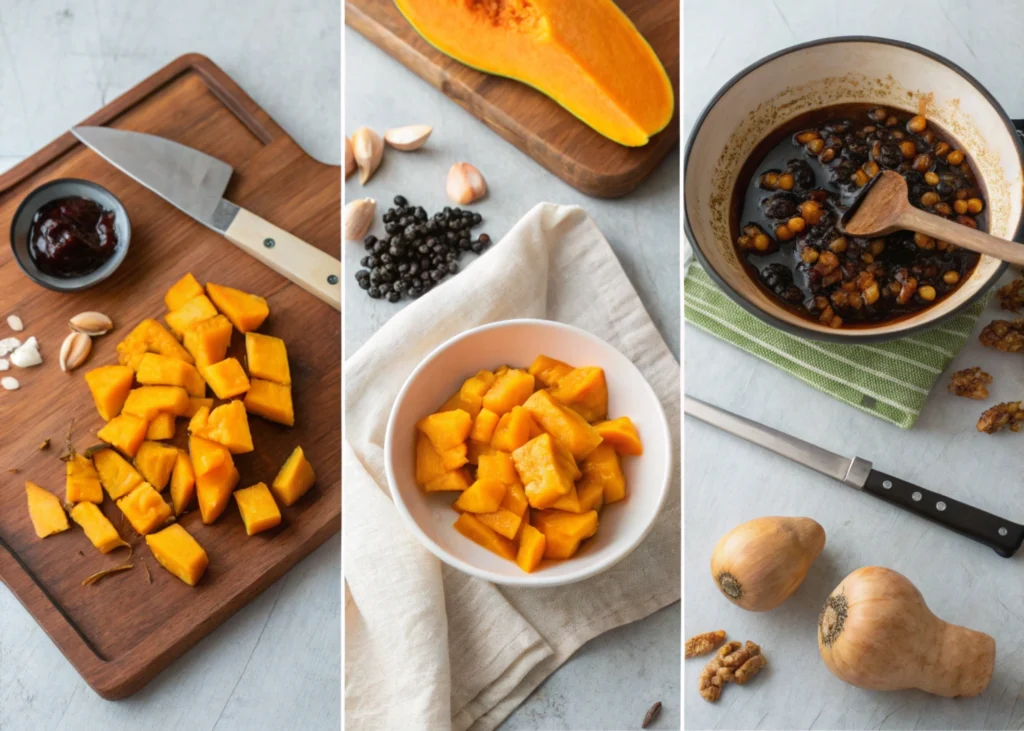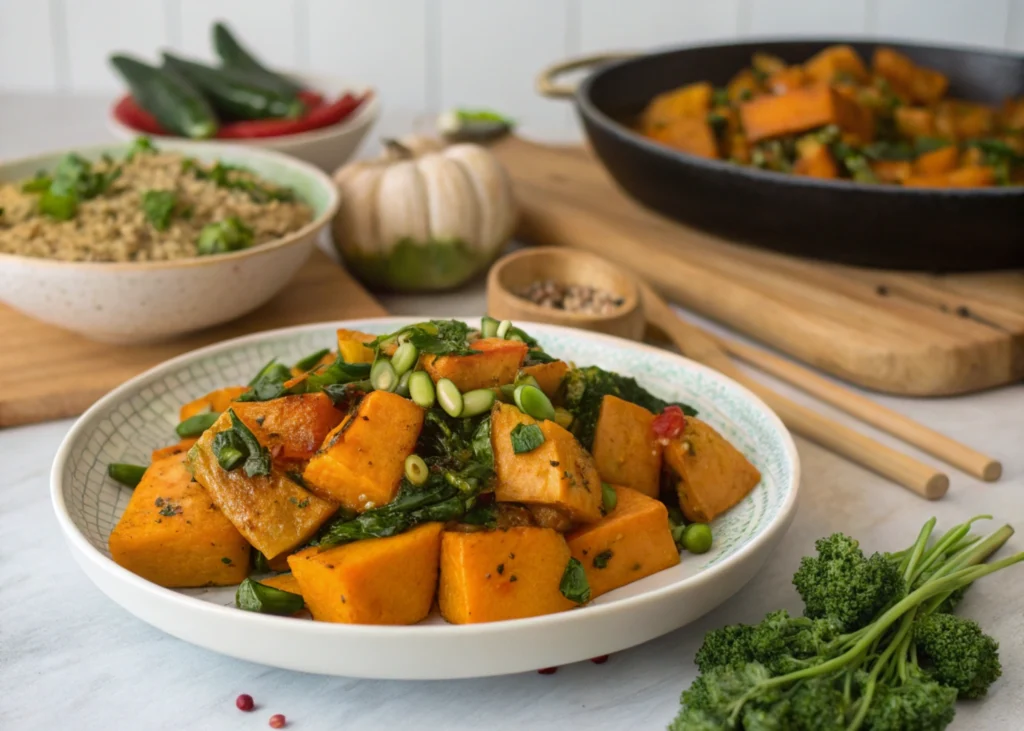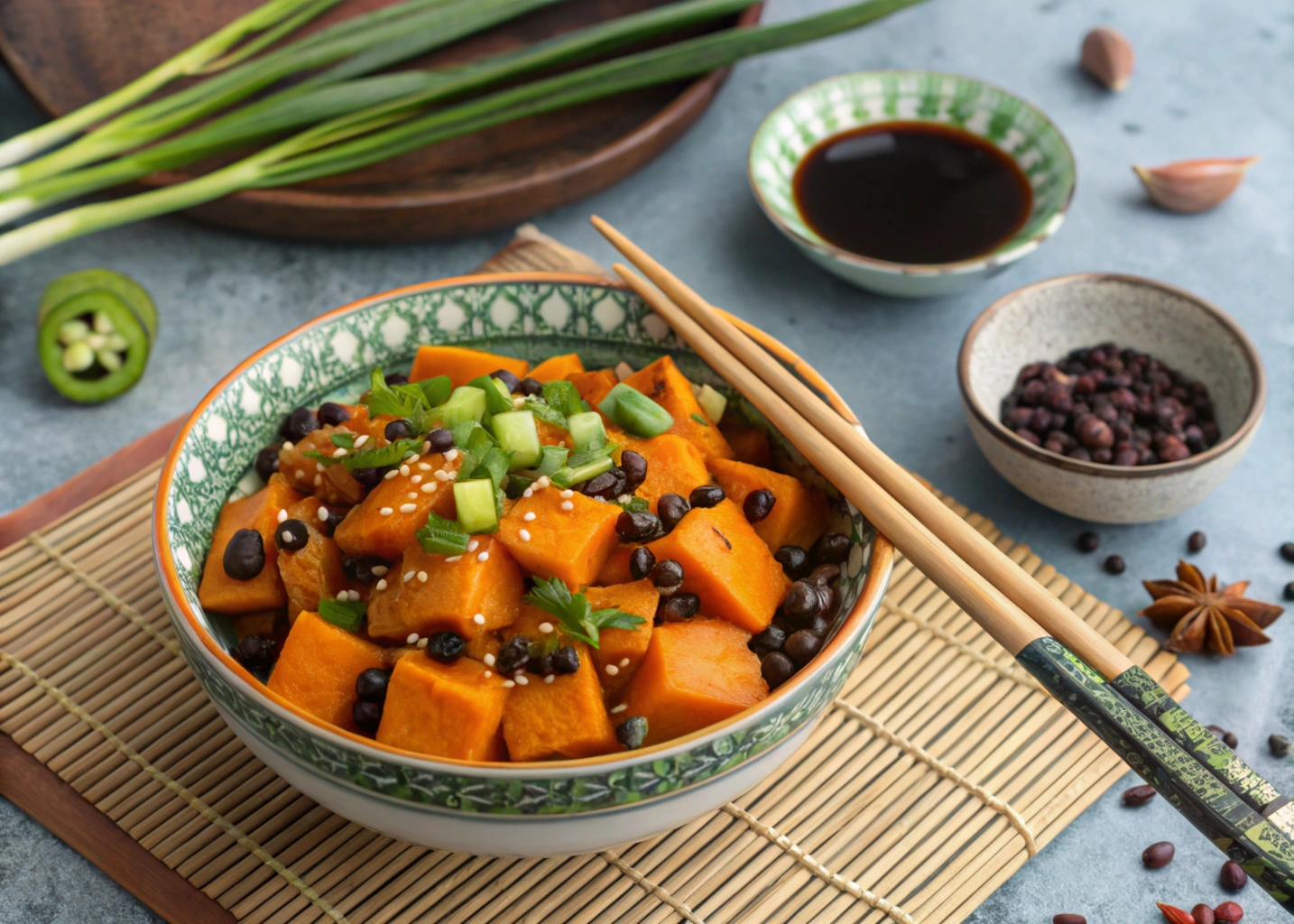When it comes to comfort food with a healthy twist, vegan Chinese recipes featuring kabocha squash are a standout choice. Whether you’re trying to whip up something hearty for a cozy dinner or impress friends with plant-based flavors, this article has got you covered. From step-by-step guides to nutritional insights, we’ll dive into everything you need to know to make your Chinese squash recipes kabocha vegan dreams a reality. So grab a cup of tea, settle in, and let’s get started!
Part 1: Introduction to Chinese Squash Recipes Kabocha Vegan
What is Kabocha Squash?
Kabocha squash, often referred to as Japanese pumpkin, is a winter squash cherished for its sweet, nutty flavor and smooth texture. It’s the perfect base for vegan recipes because of its natural creaminess and ability to pair well with Chinese spices like ginger, garlic, and soy sauce.
Why Kabocha Squash is Perfect for Vegan Chinese Recipes
In Chinese squash recipes kabocha vegan, this ingredient is a game-changer. Its flesh soaks up seasonings like soy sauce, sesame oil, and five-spice powder beautifully. Whether you’re making soups, stir-fries, or even steamed dumplings, kabocha’s flavor profile makes it a star in Chinese-inspired vegan cooking.
Nutritional Benefits of Kabocha Squash
Kabocha isn’t just delicious—it’s incredibly good for you. Packed with fiber, vitamins A and C, and beta-carotene, it’s a nutrient powerhouse. In vegan diets, it offers a filling and satisfying element without the heaviness of animal-based ingredients. Plus, its low-calorie count makes it ideal for guilt-free indulgence in Chinese dishes.
Part 2: Popular Recipes for Chinese Squash Recipes Kabocha Vegan
When it comes to Chinese squash recipes kabocha vegan, the possibilities are endless. From savory braises to creamy curries, kabocha squash is a versatile ingredient that shines in plant-based Chinese dishes. Below are some must-try recipes that are sure to become favorites in your vegan repertoire.
Braised Kabocha Squash with Fermented Black Beans
This recipe is a classic in Chinese squash recipes kabocha vegan. The fermented black beans bring a salty, umami flavor that perfectly complements the natural sweetness of the kabocha squash.
- Ingredients: Kabocha squash, fermented black beans, soy sauce, ginger, garlic, and scallions.
- Cooking Tip: Make sure to sauté the black beans with garlic and ginger first to release their full aroma before adding the squash.
- Serving Suggestion: Pair with steamed rice or noodles for a complete meal.
Curried Kabocha Squash with Coconut Milk
While curry might not scream traditional Chinese, it’s a fusion dish loved by many. This vegan kabocha curry is rich and comforting.
- Ingredients: Kabocha squash, coconut milk, curry powder, soy sauce, and vegetables like bok choy or snow peas.
- Cooking Tip: Simmer the squash in the coconut milk until it’s soft and the flavors meld together.
- Serving Suggestion: Serve it with jasmine rice or crusty bread to soak up the sauce.
Berbere Roasted Kabocha Squash with a Chinese Twist
Roasted kabocha squash with a dusting of Chinese five-spice powder and a drizzle of tahini sauce is a bold and flavorful dish.
- Ingredients: Kabocha squash, Chinese five-spice powder, tahini, lemon juice, and sesame seeds.
- Cooking Tip: Roast the squash at a high temperature (around 425°F) to get crispy edges and a caramelized flavor.
- Serving Suggestion: Use this as a topping for salads or as a side dish for other Chinese-inspired mains.
Chickpea Kabocha Fries with Soy Dipping Sauce
If you’re looking for something snack-worthy, these kabocha fries are perfect. They’re crispy, slightly sweet, and pair wonderfully with a savory soy-based dipping sauce.
- Ingredients: Kabocha squash, chickpea flour, soy sauce, and garlic powder.
- Cooking Tip: Coat the squash slices evenly in chickpea flour and bake or air-fry for a healthier version.
- Serving Suggestion: Enjoy as a snack or appetizer with a spicy chili oil dip.

Part 3: Step-by-Step Guide to Preparing Chinese Squash Recipes Kabocha Vegan
To make the most of your Chinese squash recipes kabocha vegan, proper preparation and cooking techniques are key. Here’s a handy guide to help you get it just right.
Selecting and Preparing Kabocha Squash
- How to Pick the Best Kabocha: Look for a squash with a dark green, firm skin and no soft spots. The heavier it feels for its size, the better.
- Prepping the Squash: Wash it thoroughly since the skin is edible. Cut it in half, scoop out the seeds (save them to roast!), and slice into your desired shape.
Essential Ingredients and Substitutions
- Staples for Vegan Chinese Cooking: Soy sauce, sesame oil, ginger, garlic, and fermented black beans are must-haves for authentic flavors.
- Vegan Substitutions: Replace fish sauce with tamari mixed with a dash of seaweed for that umami kick. Coconut milk is a great substitute for cream in curries or soups.
Cooking Techniques for Optimal Flavor and Texture
- Braising: This method is perfect for retaining the squash’s moisture and absorbing bold flavors. Add just enough liquid to create a sauce while cooking.
- Roasting: For caramelized, crispy textures, roast at high heat and flip halfway through cooking.
- Stir-Frying: Quick and flavorful, stir-frying lets the squash shine with a slightly charred taste.
Part 4: Nutritional Profile and Health Benefits of Kabocha Squash
Kabocha squash, a staple in Chinese squash recipes kabocha vegan, is not only delicious but also packed with nutrients that support a healthy lifestyle.
Vitamins and Minerals Abundant in Kabocha
Kabocha squash is rich in vitamin A, essential for eye health, and vitamin C, which boosts the immune system. It also provides B vitamins, iron, and beta-carotene, contributing to overall well-being.
Health Advantages of a Vegan Diet Rich in Kabocha Squash
Incorporating kabocha into a vegan diet offers numerous health benefits. Its high fiber content aids digestion and promotes satiety, which can be beneficial for weight management. The antioxidants present help combat oxidative stress, reducing the risk of chronic diseases. Additionally, kabocha’s low-calorie yet nutrient-dense profile makes it an excellent choice for those seeking to maintain a balanced diet.
Part 5: Frequently Asked Questions (FAQs)
When exploring Chinese squash recipes kabocha vegan, you might have some questions. Here are answers to common inquiries:
What are some vegan substitutes for fish sauce in Chinese recipes?
A popular vegan alternative to fish sauce is a mixture of soy sauce and seaweed, which mimics the umami flavor. You can also use tamari or coconut aminos with a splash of lime juice for added tanginess.
Can I eat the skin of Kabocha squash?
Yes, the skin of kabocha squash is edible and becomes tender when cooked. Just be sure to wash it thoroughly before cooking.
How do I store leftover cooked Kabocha squash dishes?
Store leftovers in an airtight container in the refrigerator for up to 3-4 days. To reheat, gently warm on the stove or in the microwave until heated through.
What other Chinese vegetables pair well with Kabocha in vegan recipes?
Kabocha pairs well with vegetables like bok choy, shiitake mushrooms, and snow peas. These combinations enhance the flavor and nutritional value of your dishes.
By incorporating kabocha squash into your vegan Chinese cooking, you can enjoy flavorful, nutritious, and satisfying meals. Whether you’re new to this ingredient or a seasoned cook, these insights and recipes will help you make the most of kabocha in your culinary adventures.
Part 6: Tips for Perfecting Chinese Squash Recipes Kabocha Vegan
Perfecting Chinese squash recipes kabocha vegan is not as tricky as it might seem. With the right strategies and a little practice, you can make consistently delicious dishes that everyone will enjoy. To help you get there, here are some practical tips.
Balancing Flavors in Vegan Chinese Recipes
When cooking Chinese dishes, achieving a balance of flavors is key. For example, sweetness can be enhanced by letting the natural sugars in kabocha squash shine, but adding a drizzle of agave or a pinch of sugar can deepen the taste. On the other hand, umami flavors can be amplified by using fermented black beans, tamari, or mushroom-based seasonings. Meanwhile, a touch of chili oil or fresh ginger can add a hint of heat to round out the flavor profile.
Making Prep and Cooking More Efficient
Efficiency in the kitchen makes cooking Chinese squash recipes kabocha vegan even more enjoyable. For instance, prepping your squash in advance—peeling, seeding, and slicing it—saves time when you’re ready to cook. Additionally, using sharp tools, like a chef’s knife, makes handling kabocha’s tough skin much easier. Moreover, consider batch cooking. By doubling the recipe, you can freeze extras for quick and convenient meals later.
Serving Suggestions for Chinese Squash Recipes Kabocha Vegan
To make your kabocha dishes more satisfying, serve them with jasmine rice, quinoa, or rice noodles. Furthermore, adding garnishes like fresh herbs, scallions, or sesame seeds enhances both the presentation and flavor of the meal.
Part 7: Why Chinese Squash Recipes Kabocha Vegan Should Be in Your Meal Rotation
Adding Chinese squash recipes kabocha vegan to your meal rotation isn’t just a tasty choice; it’s also practical, healthy, and incredibly versatile. Whether you’re meal prepping or exploring new cuisines, kabocha squash is a fantastic ingredient to include.
Affordable and Accessible Ingredients
First of all, kabocha squash is budget-friendly and widely available, especially during the fall and winter. Furthermore, its long shelf life means you can stock up and use it whenever inspiration strikes. Additionally, most of the ingredients used in these recipes—like soy sauce, sesame oil, and garlic—are inexpensive pantry staples.
A Versatile Addition to Vegan Meals
Another great thing about kabocha squash is how easily it adapts to different dishes. For instance, you can enjoy it roasted, steamed, or pureed in soups. Whether you’re craving a warm stew or a crispy side dish, kabocha’s versatility makes it an ideal choice for anyone looking to add variety to their vegan meals.
Ideal for Meal Prepping
If you’re into meal prepping, kabocha squash is a dream ingredient. Not only does it store well, but its flavor also develops over time, making dishes taste even better the next day. For example, you can prepare a big batch of braised kabocha squash or roasted slices, store them in the fridge, and reheat them as needed.
Encouraging Plant-Based Eating
Finally, incorporating kabocha squash into your vegan meals is a simple way to encourage plant-based eating. Its rich, satisfying texture and natural sweetness appeal to everyone, even those who aren’t strictly vegan.
For more ideas to expand your meal rotation, check out our Recipe Collection. It’s packed with inspiration to keep your meals exciting and plant-focused.
Part 8: Seasonal Ideas for Chinese Squash Recipes Kabocha Vegan
Cooking with seasonal ingredients not only enhances flavor but also ensures that your dishes remain exciting throughout the year. While kabocha squash shines in fall and winter, it can easily be adapted for any season, allowing your Chinese squash recipes kabocha vegan to stand out year-round.
Fall and Winter: Warm, Comforting Dishes
During the colder months, kabocha squash is at its sweetest and creamiest. It’s perfect for hearty recipes that warm the soul.
- Braised Kabocha Squash Stew: Adding tofu, mushrooms, and soy sauce creates a rich and savory dish that’s ideal for chilly evenings.
- Kabocha Squash Dumplings: Filling dumplings with mashed squash, scallions, and sesame oil offers a cozy, satisfying meal.
- Spiced Kabocha Soup: A creamy soup seasoned with ginger and Chinese five-spice powder is exactly what you need on a cold day.
Spring and Summer: Lighter, Fresher Meals
Although kabocha squash is less common in warmer months, it still works beautifully in light, refreshing dishes.
- Kabocha Squash Noodle Salad: Roasted squash slices combined with chilled rice noodles, cucumber, and a sesame dressing make for a cooling meal.
- Kabocha and Edamame Stir-Fry: Quick to prepare, this dish is packed with protein and fresh flavors, making it great for spring lunches.
- Grilled Kabocha Skewers: Marinating squash chunks in soy sauce, garlic, and sesame oil before grilling is perfect for summer cookouts.
For even more seasonal recipe ideas, take a look at our Guide to Vegan Seasonal Recipes, where you’ll find plenty of inspiration to match your mood and the time of year.
Part 9: Expert Tips for Experimenting with Chinese Squash Recipes Kabocha Vegan
When it comes to experimenting in the kitchen, kabocha squash is one of the most versatile ingredients to work with. Whether you’re adding a personal touch to traditional recipes or repurposing leftovers, these tips will help you create unforgettable dishes.
How to Customize Recipes to Your Taste
Personalizing Chinese squash recipes kabocha vegan is easier than you might think. For example, adding protein like tofu, tempeh, or chickpeas transforms a light dish into a filling meal. Additionally, experimenting with spices, such as substituting Chinese five-spice powder with garam masala or smoked paprika, can bring new dimensions to your recipes. Moreover, pairing kabocha with vegetables like broccoli or zucchini adds both variety and nutritional value.
Creative Ways to Use Leftovers
Leftovers don’t have to be boring. In fact, they can spark creativity.
- Kabocha Squash Spread: By mashing cooked squash with tahini and garlic, you’ll have a delicious spread for toast or crackers.
- Squash Fried Rice: Diced leftover kabocha makes an excellent addition to fried rice for a quick and satisfying meal.
- Savory Pancakes: Mixing mashed squash with chickpea flour is a fun way to create crispy, flavorful pancakes.

Experimenting Beyond Traditional Recipes
If you’re feeling adventurous, why not step outside the box? For instance, try creating a kabocha squash taco with hoisin sauce for a fusion twist. Alternatively, use mashed squash as a filling for vegan buns or custards to explore dessert options.
For more creative ideas, visit our Creative Recipe Ideas. You’ll discover how versatile and exciting kabocha squash can be when experimenting with vegan dishes.


3 thoughts on “Exploring Vegan Chinese Kabocha Squash Recipes”